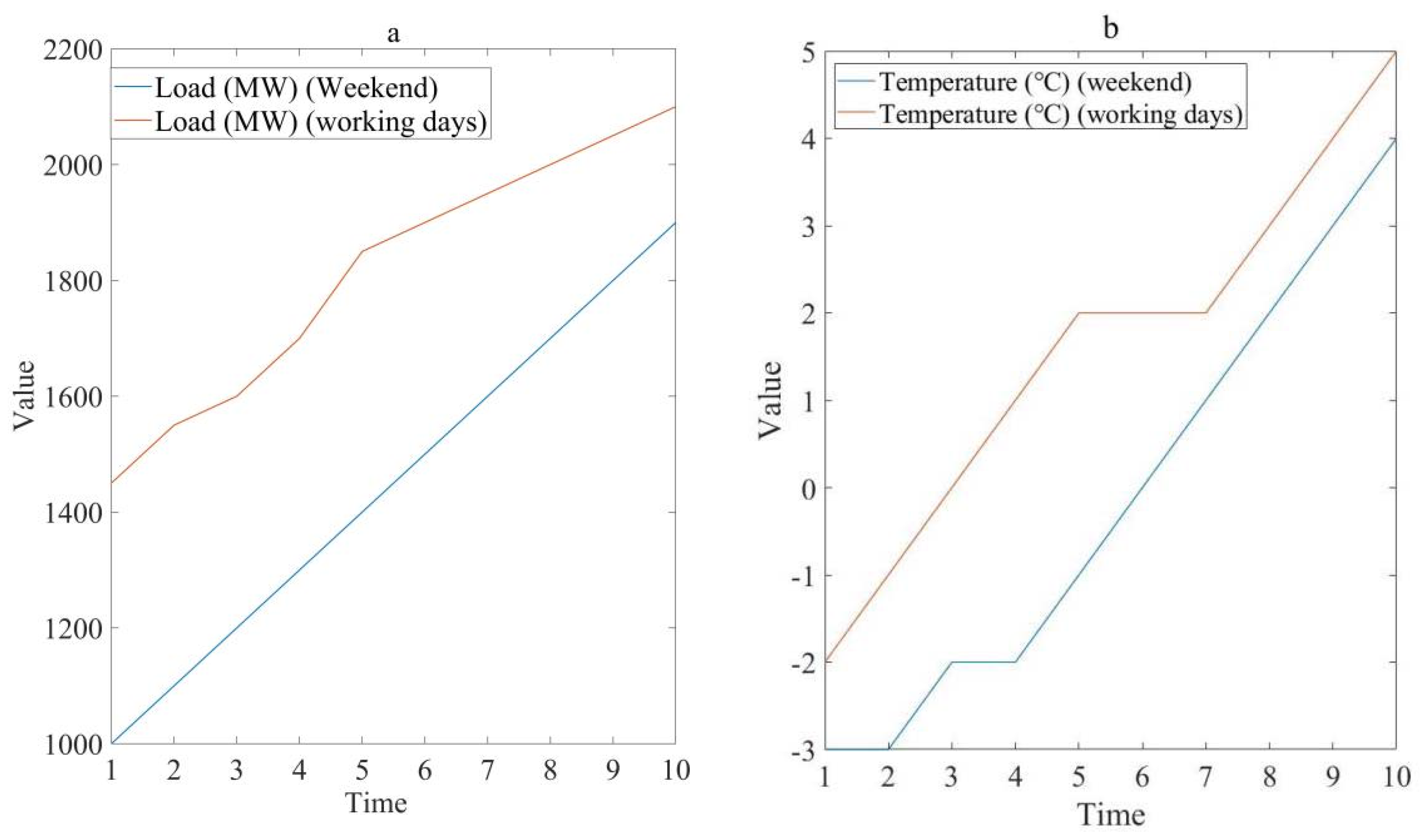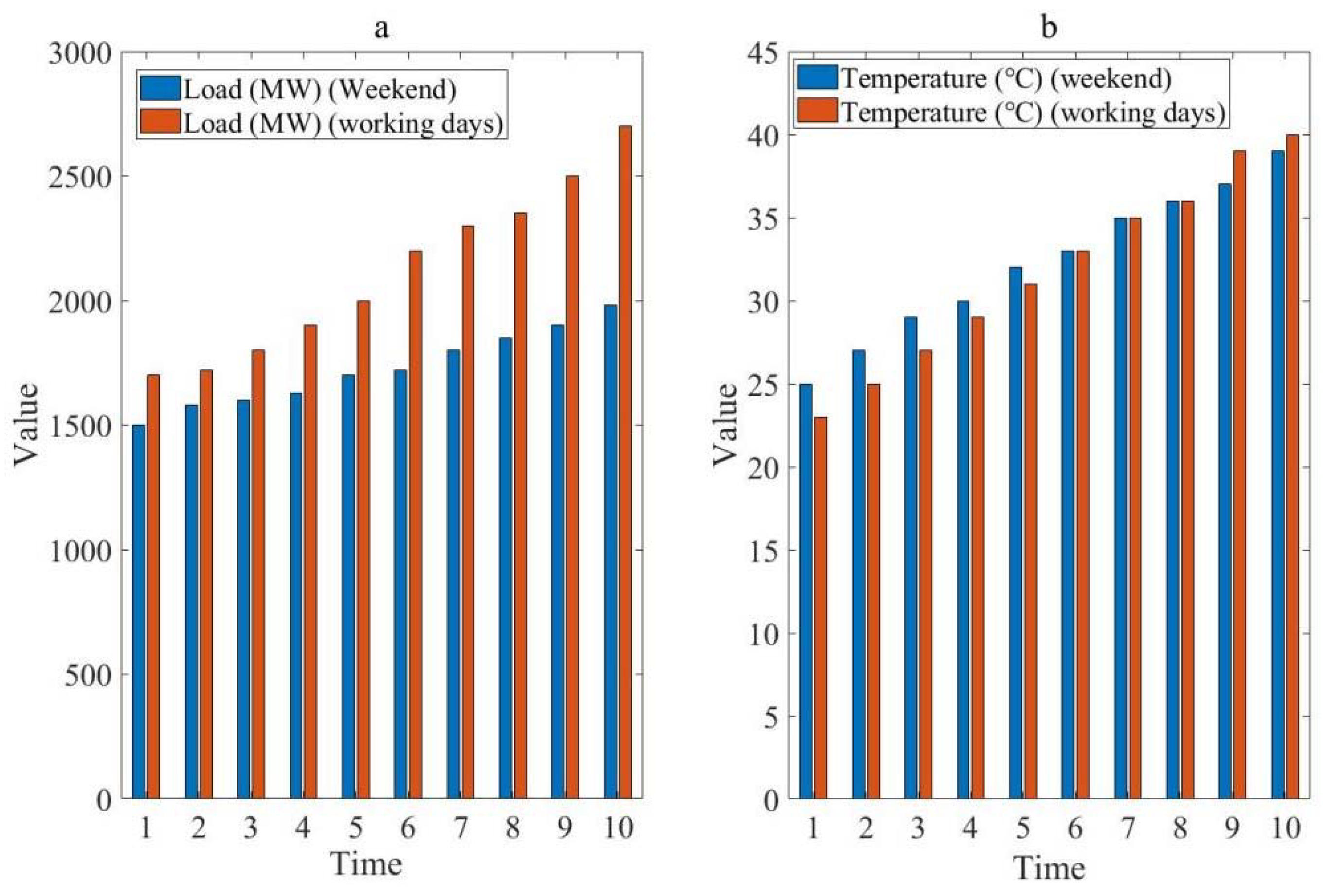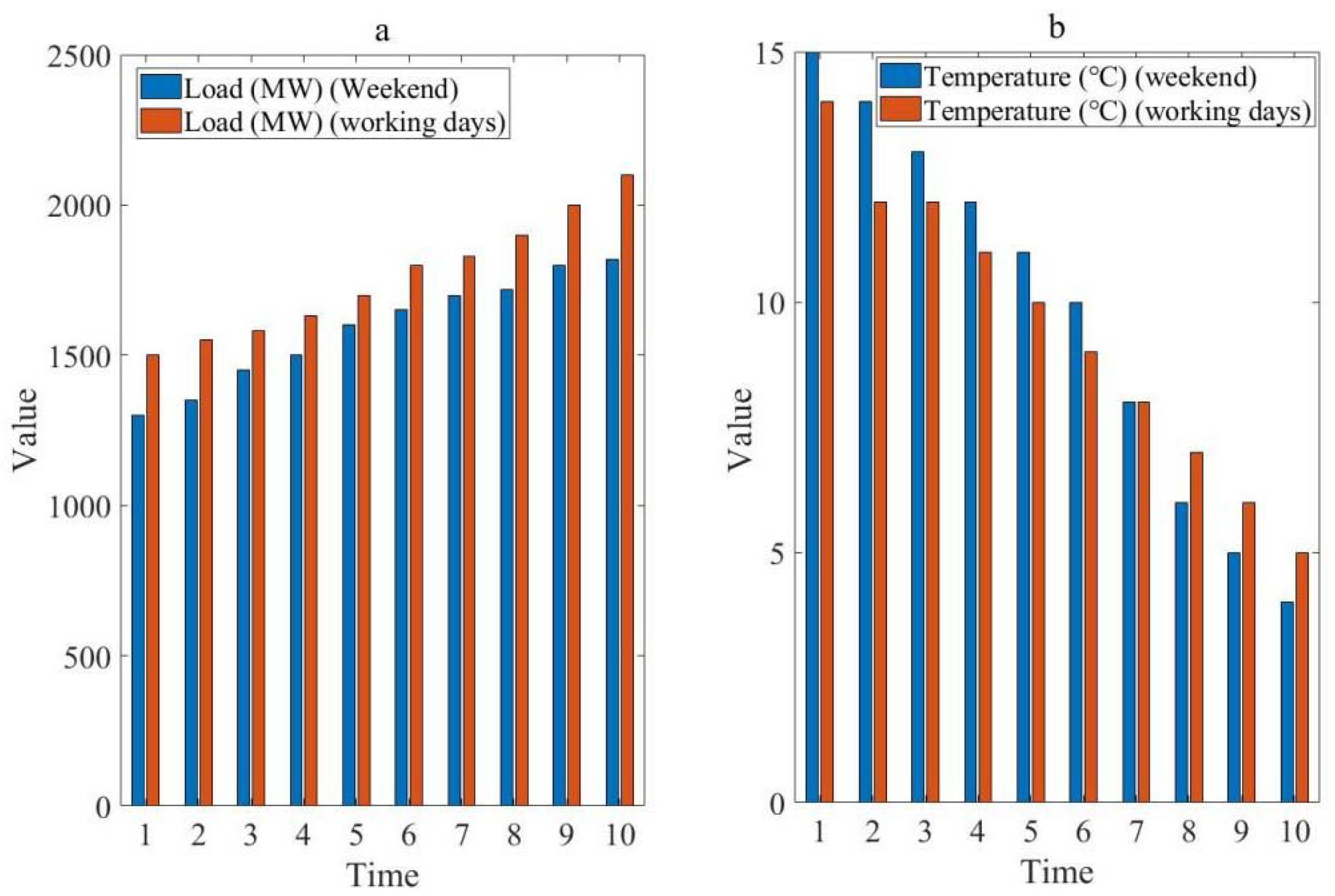Electricity Correlation Evaluation Based on Improved Logistic Algorithm Integrating Periodic Characteristics of Load and Temperature
Abstract
1. Introduction
2. Power Correlation Evaluation Based on Improved Logistic Algorithm
2.1. Evaluation of Electricity Relevance
2.2. Logistic Algorithm
2.3. Improved Logistic Algorithm
2.4. Evaluation of Electricity Relevance by Integrating the Periodic Characteristics of Load and Temperature
3. Experimental Evaluation of the Power Correlation between the Periodic Characteristics of Load and Temperature
3.1. Experimental Design
- (1)
- Research background and significance
- (2)
- Experimental purpose
- (3)
- Experimental content
- (4)
- Expected results of the experiment
3.2. Evaluation of Regression Model Prediction Accuracy
3.3. Evaluation of the Correlation between Load and Temperature Periodicity Characteristics and Electricity
3.4. Power Dispatch and Resource Allocation Plan
4. Conclusions
Author Contributions
Funding
Data Availability Statement
Conflicts of Interest
References
- Zhang, C.; Xu, Y.; Li, Z.; Dong, Z.Y. Robustly Coordinated Operation of a Multi-Energy Microgrid With Flexible Electric and Thermal Loads. IEEE Trans. Smart Grid 2018, 10, 2765–2775. [Google Scholar] [CrossRef]
- Xianlun, T.; Dai, Y.; Wang, T.; Chen, Y. Short-term power load forecasting based on multi-layer bidirectional recurrent neural network. IET Gener. Transm. Distrib. 2019, 13, 3847–3854. [Google Scholar]
- Wu, F.; Cattani, C.; Song, W.; Zio, E. Fractional ARIMA with an improved cuckoo search optimization for the efficient Short-term power load forecasting. Alex. Eng. J. 2020, 59, 3111–3118. [Google Scholar] [CrossRef]
- Ouyang, T.; He, Y.; Li, H.; Sun, Z.; Baek, S. Modeling and Forecasting Short-Term Power Load With Copula Model and Deep Belief Network. IEEE Trans. Emerg. Top. Comput. Intell. 2019, 3, 127–136. [Google Scholar] [CrossRef]
- Olufemi, A.O.; Niu, H. Artificial intelligence techniques in smart grid: A survey. Smart Cities 2021, 4, 548–568. [Google Scholar]
- Zhao, Y.; Foong, L.K. Predicting electrical power output of combined cycle power plants using a novel artificial neural network optimized by electrostatic discharge algorithm. Measurement 2022, 198, 111405. [Google Scholar] [CrossRef]
- Kamila, M. Construction of Environmental Economic Dispatching Model Based on Electricity Market Environment. Acad. J. Environ. Biol. 2021, 2, 401. [Google Scholar] [CrossRef]
- Li, G.; Wang, Q.; Zuo, C. Emergency lane vehicle detection and classification method based on logistic regression and a deep convolutional network. Neural Comput. Appl. 2021, 34, 12517–12526. [Google Scholar] [CrossRef]
- Dong, X.; Deng, S.; Wang, D. A short-term power load forecasting method based on k-means and SVM. J. Ambient. Intell. Humaniz. Comput. 2021, 13, 5253–5267. [Google Scholar] [CrossRef]
- Xia, C.; Zhang, M.; Cao, J. A hybrid application of soft computing methods with wavelet SVM and neural network to electric power load forecasting. J. Electr. Syst. Inf. Technol. 2018, 5, 681–696. [Google Scholar] [CrossRef]
- Li, X.; Zhang, X.; Jiang, W.; Wang, J.; Wang, P.; Wu, X. A Novel Assorted Nonlinear Stabilizer for DC–DC Multilevel Boost Converter with Constant Power Load in DC Microgrid. IEEE Trans. Power Electron. 2020, 35, 11181–11192. [Google Scholar] [CrossRef]
- Martinez-Trevino, B.A.; El Aroudi, A.; Valderrama-Blavi, H.; Cid-Pastor, A.; Vidal-Idiarte, E.; Martinez-Salamero, L. PWM Nonlinear Control with Load Power Estimation for Output Voltage Regulation of a Boost Converter with Constant Power Load. IEEE Trans. Power Electron. 2020, 36, 2143–2153. [Google Scholar] [CrossRef]
- Zhang, W.; Qin, J.; Mei, F.; Fu, J.; Dai, B.; Yu, W. Short-term power load forecasting using integrated methods based on long short-term memory. Sci. China Technol. Sci. 2020, 63, 614–624. [Google Scholar] [CrossRef]
- Hatziargyriou, N.; Milanovic, J.; Rahmann, C.; Ajjarapu, V.; Canizares, C.; Erlich, I.; Hill, D.; Hiskens, I.; Kamwa, I.; Pal, B.; et al. Definition and Classification of Power System Stability–Revisited & Extended. IEEE Trans. Power Syst. 2020, 36, 3271–3281. [Google Scholar] [CrossRef]
- Karami, Z.; Shafiee, Q.; Sahoo, S.; Yaribeygi, M.; Bevrani, H.; Dragicevic, T. Hybrid Model Predictive Control of DC–DC Boost Converters with Constant Power Load. IEEE Trans. Energy Convers. 2020, 36, 1347–1356. [Google Scholar] [CrossRef]
- Venkataramana, V.; Chandra, D.R.; Salkuti, S.R. Short-term electric power load forecasting using factor analysis and long short-term memory for smart cities. Int. J. Circuit Theory Appl. 2021, 49, 1678–1703. [Google Scholar]
- Soriano-Rangel, C.A.; He, W.; Mancilla-David, F.; Ortega, R. Voltage Regulation in Buck–Boost Converters Feeding an Unknown Constant Power Load: An Adaptive Passivity-Based Control. IEEE Trans. Control Syst. Technol. 2020, 29, 395–402. [Google Scholar] [CrossRef]
- Hosseinzadehtaher, M.; Khan, A.; Easley, M.; Shadmand, M.B.; Fajri, P. Self-Healing Predictive Control of Battery System in Naval Power System with Pulsed Power Loads. IEEE Trans. Energy Convers. 2020, 36, 1056–1069. [Google Scholar] [CrossRef]
- Vafamand, N.; Mardani, M.M.; Khooban, M.H.; Blaabjerg, F.; Boudjadar, J. Pulsed power load effect mitigation in DC shipboard microgrids: A constrained modelpredictive approach. IET Power Electron. 2019, 12, 2155–2160. [Google Scholar] [CrossRef]
- Umair, S. Resilience in electric power systems. J. Electr. Eng. Electron. Control Comput. Sci. 2020, 7, 1–6. [Google Scholar]
- Okundamiya, M. Size optimization of a hybrid photovoltaic/fuel cell grid connected power system including hydrogen storage. Int. J. Hydrogen Energy 2020, 46, 30539–30546. [Google Scholar] [CrossRef]
- Sharma, G.; Panwar, A.; Arya, Y.; Kumawat, M. Integrating layered recurrent ANN with robust control strategy for diverse operating conditions of AGC of the power system. IET Gener. Transm. Distrib. 2020, 14, 3886–3895. [Google Scholar] [CrossRef]
- Sharaf, M.; Yousef, M.S.; Huzayyin, A.S. Review of cooling techniques used to enhance the efficiency of photovoltaic power systems. Environ. Sci. Pollut. Res. 2022, 29, 26131–26159. [Google Scholar] [CrossRef] [PubMed]





| Features | Algorithm | Accuracy | |
|---|---|---|---|
| Experimental Group 1 | Only fuse load characteristics | Logistic regression | 0.75 |
| Experimental Group 2 | Merging only the periodic characteristics of temperature | Logistic regression | 0.68 |
| Experimental Group 3 | Integrating the periodic characteristics of load and temperature | Logistic regression | 0.81 |
| Experimental Group 4 | Integrating the periodic characteristics of load and temperature | Improved Logistic Regression | 0.89 |
| Predictive Techniques | Factors Considered in Power Load Analysis/Forecasting | Benefits of Analysis |
|---|---|---|
| Improved Logistic Algorithm | Comprehensive load cycle characteristics and temperature cycle characteristics | Better capture of the correlation between load and temperature, improve the accuracy and stability of power load analysis/prediction |
| ARIMA model | Historical load data, seasonal changes, trend changes | Considering the trend and seasonal changes of historical load data, it is suitable for long-term load forecasting and can better capture changes in time series |
| Artificial neural network | Multiple input features (such as weather, industrial activities, etc.), historical load data | Can handle complex nonlinear relationships, has certain generalization ability, and can adapt to new input data |
| Support Vector Machine | Multiple input features (such as weather, date, holidays, etc.) | Can handle high-dimensional data and has good classification and prediction ability for nonlinear problems |
| Time series analysis methods | Historical load data, seasonal changes, trend changes | It can predict the load changes in the future and capture the periodicity and trend of the time series |
Disclaimer/Publisher’s Note: The statements, opinions and data contained in all publications are solely those of the individual author(s) and contributor(s) and not of MDPI and/or the editor(s). MDPI and/or the editor(s) disclaim responsibility for any injury to people or property resulting from any ideas, methods, instructions or products referred to in the content. |
© 2023 by the authors. Licensee MDPI, Basel, Switzerland. This article is an open access article distributed under the terms and conditions of the Creative Commons Attribution (CC BY) license (https://creativecommons.org/licenses/by/4.0/).
Share and Cite
Zhang, X.; Hou, K.; Yang, J.; Hu, J.; Yao, G.; Zhang, J. Electricity Correlation Evaluation Based on Improved Logistic Algorithm Integrating Periodic Characteristics of Load and Temperature. Energies 2023, 16, 5762. https://doi.org/10.3390/en16155762
Zhang X, Hou K, Yang J, Hu J, Yao G, Zhang J. Electricity Correlation Evaluation Based on Improved Logistic Algorithm Integrating Periodic Characteristics of Load and Temperature. Energies. 2023; 16(15):5762. https://doi.org/10.3390/en16155762
Chicago/Turabian StyleZhang, Xiaotian, Kaiyuan Hou, Junjie Yang, Jiyun Hu, Guangzhi Yao, and Jiannan Zhang. 2023. "Electricity Correlation Evaluation Based on Improved Logistic Algorithm Integrating Periodic Characteristics of Load and Temperature" Energies 16, no. 15: 5762. https://doi.org/10.3390/en16155762
APA StyleZhang, X., Hou, K., Yang, J., Hu, J., Yao, G., & Zhang, J. (2023). Electricity Correlation Evaluation Based on Improved Logistic Algorithm Integrating Periodic Characteristics of Load and Temperature. Energies, 16(15), 5762. https://doi.org/10.3390/en16155762








